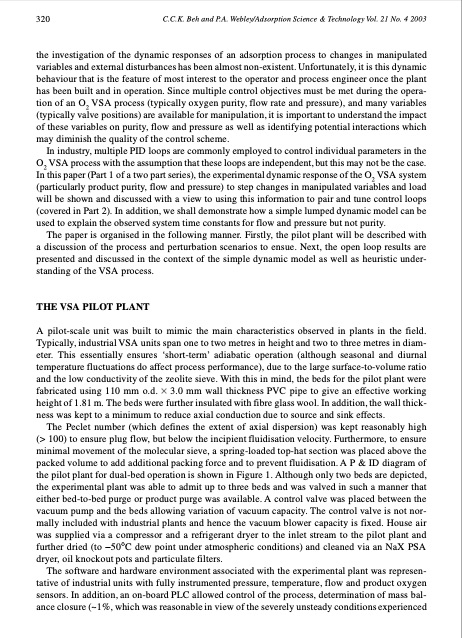
PDF Publication Title:
Text from PDF Page: 002
320 C.C.K. Beh and P.A. Webley/Adsorption Science & Technology Vol. 21 No. 4 2003 the investigation of the dynamic responses of an adsorption process to changes in manipulated variables and external disturbances has been almost non-existent. Unfortunately, it is this dynamic behaviour that is the feature of most interest to the operator and process engineer once the plant has been built and in operation. Since multiple control objectives must be met during the opera- tion of an O2 VSA process (typically oxygen purity, flow rate and pressure), and many variables (typically valve positions) are available for manipulation, it is important to understand the impact of these variables on purity, flow and pressure as well as identifying potential interactions which may diminish the quality of the control scheme. In industry, multiple PID loops are commonly employed to control individual parameters in the O2 VSA process with the assumption that these loops are independent, but this may not be the case. In this paper (Part 1 of a two part series), the experimental dynamic response of the O2 VSA system (particularly product purity, flow and pressure) to step changes in manipulated variables and load will be shown and discussed with a view to using this information to pair and tune control loops (covered in Part 2). In addition, we shall demonstrate how a simple lumped dynamic model can be used to explain the observed system time constants for flow and pressure but not purity. The paper is organised in the following manner. Firstly, the pilot plant will be described with a discussion of the process and perturbation scenarios to ensue. Next, the open loop results are presented and discussed in the context of the simple dynamic model as well as heuristic under- standing of the VSA process. THE VSA PILOT PLANT A pilot-scale unit was built to mimic the main characteristics observed in plants in the field. Typically, industrial VSA units span one to two metres in height and two to three metres in diam- eter. This essentially ensures ‘short-term’ adiabatic operation (although seasonal and diurnal temperature fluctuations do affect process performance), due to the large surface-to-volume ratio and the low conductivity of the zeolite sieve. With this in mind, the beds for the pilot plant were fabricated using 110 mm o.d. 3.0 mm wall thickness PVC pipe to give an effective working height of 1.81 m. The beds were further insulated with fibre glass wool. In addition, the wall thick- ness was kept to a minimum to reduce axial conduction due to source and sink effects. The Peclet number (which defines the extent of axial dispersion) was kept reasonably high (> 100) to ensure plug flow, but below the incipient fluidisation velocity. Furthermore, to ensure minimal movement of the molecular sieve, a spring-loaded top-hat section was placed above the packed volume to add additional packing force and to prevent fluidisation. A P & ID diagram of the pilot plant for dual-bed operation is shown in Figure 1. Although only two beds are depicted, the experimental plant was able to admit up to three beds and was valved in such a manner that either bed-to-bed purge or product purge was available. A control valve was placed between the vacuum pump and the beds allowing variation of vacuum capacity. The control valve is not nor- mally included with industrial plants and hence the vacuum blower capacity is fixed. House air was supplied via a compressor and a refrigerant dryer to the inlet stream to the pilot plant and further dried (to 50 C dew point under atmospheric conditions) and cleaned via an NaX PSA dryer, oil knockout pots and particulate filters. The software and hardware environment associated with the experimental plant was represen- tative of industrial units with fully instrumented pressure, temperature, flow and product oxygen sensors. In addition, an on-board PLC allowed control of the process, determination of mass bal- ance closure (~1%, which was reasonable in view of the severely unsteady conditions experiencedPDF Image | Dynamic Response and Characteristics of an Oxygen Vacuum Swing Adsorption

PDF Search Title:
Dynamic Response and Characteristics of an Oxygen Vacuum Swing AdsorptionOriginal File Name Searched:
026361703322405051.pdfDIY PDF Search: Google It | Yahoo | Bing
CO2 Organic Rankine Cycle Experimenter Platform The supercritical CO2 phase change system is both a heat pump and organic rankine cycle which can be used for those purposes and as a supercritical extractor for advanced subcritical and supercritical extraction technology. Uses include producing nanoparticles, precious metal CO2 extraction, lithium battery recycling, and other applications... More Info
Heat Pumps CO2 ORC Heat Pump System Platform More Info
| CONTACT TEL: 608-238-6001 Email: greg@infinityturbine.com | RSS | AMP |